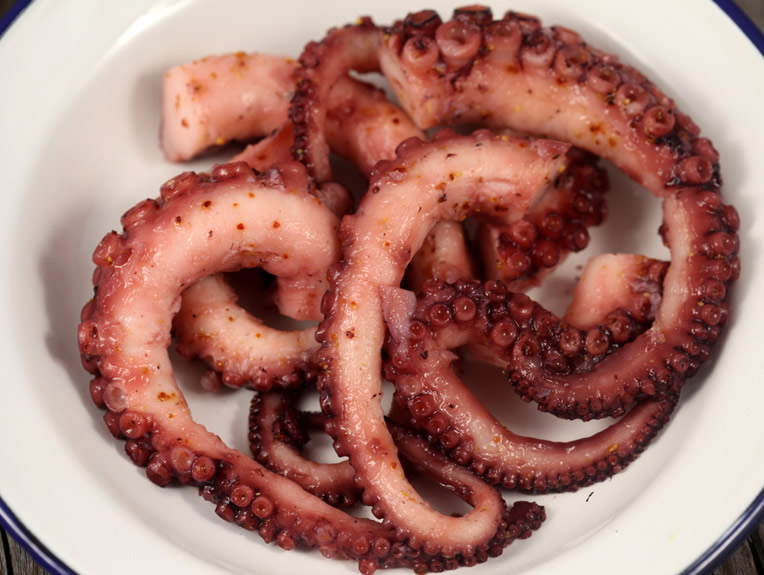PERFECTLY BOILED OCTOPUS – TENDER AND DELICIOUS EVERY TIME
I know at least three people who have been eagerly waiting for this recipe! Some have seen the photos and asked for it, others have actually tasted octopus cooked this way and were amazed at how tender it turns out. I’m thrilled to now share a technique that consistently delivers great results. Over the next few days, I’ll be sharing a few interesting recipes featuring this perfectly boiled octopus. Stay tuned!
🕒 Prep Time: 10 min
🍳 Cook Time: 1.5 hours
🍽️ Resting Time: Overnight (optional)
🍴 Serves: 4
Ingredients
- 1 octopus (1 to 1.5 kg, frozen)
- 1 glass dry white wine
- 1/2 glass water
Instructions
1. Thaw and Clean the Octopus
- Thaw the octopus in the refrigerator overnight.
- Rinse the octopus thoroughly, remove the sac, and clean out the eye located between the tentacles. Drain well.
- Place the octopus in a plastic bag and tenderize it by pounding gently with a meat mallet or similar tool.
- Rinse again. Smell the octopus to assess freshness — it should smell like fresh seawater. If it smells like stagnant or bay water, it was likely previously thawed before purchase, which may affect the final texture after cooking.
2. Pre-Cook the Octopus
- Bring water to a boil.
- Dip the octopus head-first into the boiling water for 15 seconds, remove it, and then dip it again once the water returns to a boil.
- Immediately plunge the octopus into cold water to stop the cooking process.
3. Slow Cook the Octopus
- In a heavy pot or Dutch oven (one that retains heat well), combine the white wine and water. Using a wine with higher acidity is preferred for tender results.
- Add the octopus. Optionally, add aromatics such as rosemary, bay leaf, or citrus peels (lemon or orange) for extra flavor.
- Cover the pot and place it in a preheated oven at 150°C (300°F). After 10 minutes, reduce the temperature to 120°C (250°F).
- Cook for about 1.5 hours, testing tenderness by inserting a skewer into the thickest part of the tentacles — it should slide in easily.
4. Rest and Store
- Turn off the oven and leave the octopus to cool in the cooking liquid. This allows it to continue cooking gently and become even more tender.
- Use immediately in recipes or refrigerate overnight in the cooking liquid. The liquid may become gelatinous in the fridge, which is normal.
- Stored this way, the octopus will keep in the fridge for 3-4 days.
5. Final Preparation
- The next day, remove the skin by gently scraping it off with the back of a knife.
- The octopus is now ready to be used in your favorite dishes.
💡 Tips
- A 1–1.5 kg octopus is sufficient for four servings.
- Typically, I use the center body for appetizers and the tentacles for the main course.
- Tenderizing the octopus before cooking improves texture significantly.
- Cooking low and slow in the oven helps achieve consistently tender results.
🎉 Perfect For
- Mediterranean and seafood lovers
- Special family dinners and gatherings
- Impressing guests with restaurant-quality octopus
📝 Final Thoughts
This method of slow-cooking octopus in the oven ensures a tender, flavorful result every time. By combining gentle simmering with careful resting in its own juices, the octopus becomes incredibly soft and delicious. Whether you’re preparing an elegant appetizer or a hearty main course, this technique will make your octopus dishes shine.


